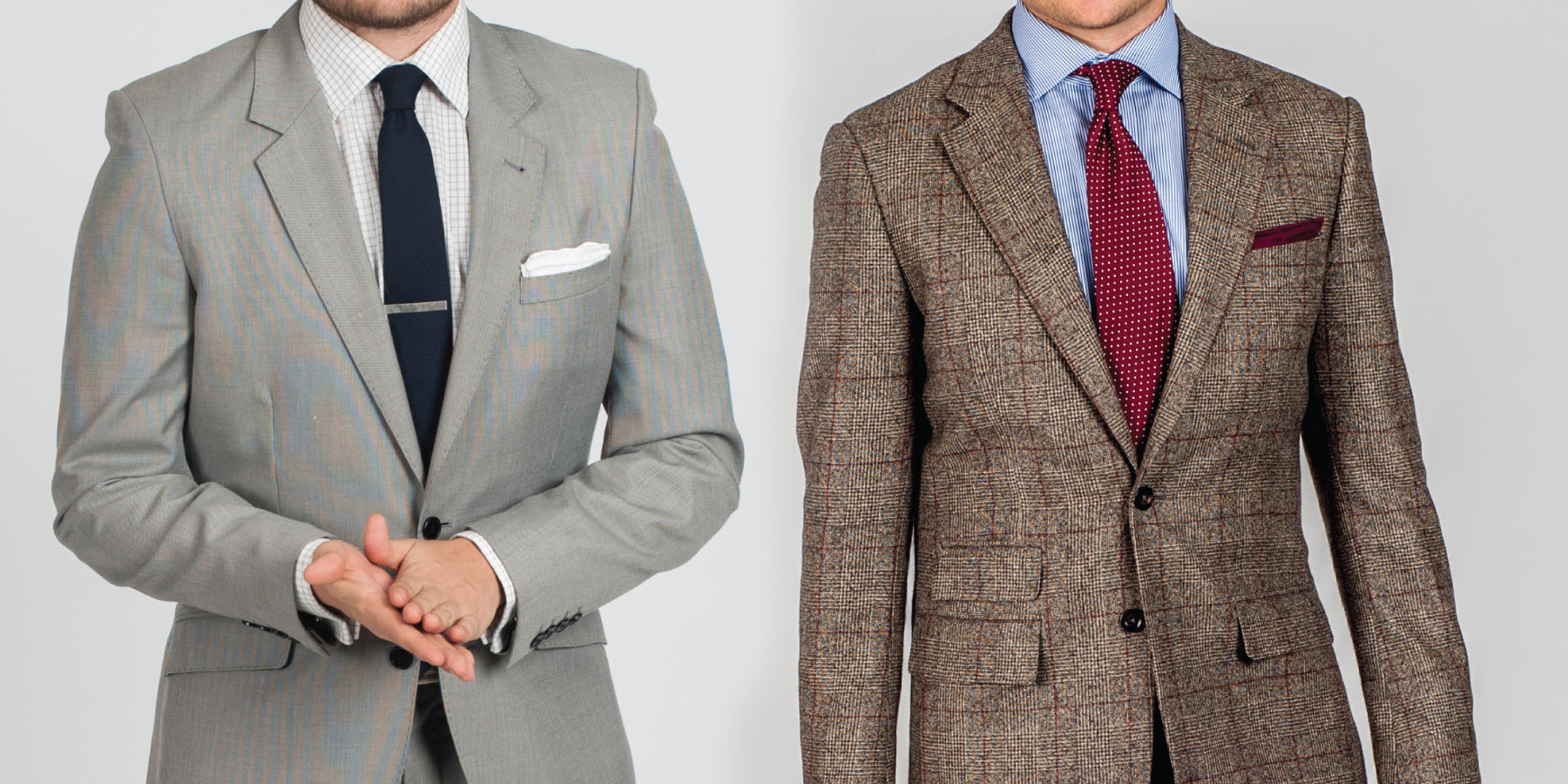In the world of men’s suiting, there is a dramatic price variation from one brand to another.
Suits can range from ninety dollars to nine thousand dollars, and up.
Here, I try to explain the difference(s) by having Townsend model his “fast fashion” suit ($189) vs. his new bespoke suit ($1,895).
$189 vs $1895
FIT
The most important element of a suit, or any garment for that matter, is how well it fits your body.
The biggest fundamental difference between these two price points: on the higher end you can afford to have the suit custom made for your body, versus choosing the “closest” fit off-the-rack.
As you can see in the photo above, there are a number of noticeable fit compromises with Towni’s $200 suit even after having it altered:
- The shoulder slopes are not adjusted for Townsend, causing a collar roll across the upper back/neck that’s so bad we can see it from the front (see the wrinkle at the top of Towni’s right shoulder, above where the lapels meet the collar).
- The shoulders are too wide, causing that unsightly pad “cliff-dimple” (see his right shoulder).
- The front chest is too big (notice the bulging extra fabric at right chest, where the body meets the bottom of the armhole)
- Slight pulling at bottom of sleeves where they connect to the body of the jacket (see bottom of armhole on Towni’s left sleeve)
- The trousers look like they fit fairly well overall (although common problem areas are not visible: crotch, waistband, pockets…)
FABRIC
Fast-fashion retailers like H&M (Zara, Topman, JcPenney, etc) cut costs by ordering cheap synthetic fabrics in major bulk quantities. In this particular case, the suit is 85% polyester/15% viscose. The major downsides of this kind of man-made cloth (other than obvious look and feel) are breathability, shape retention, and reactions to cleaning and pressing agents.
For the bespoke suit, Towni hand-picked a premium wool flannel/cashmere fabric designed and spun by Ariston in Naples Italy. It’s among the top 1% of the the most luxurious fabrics in the world. Ariston also produces all of their cloth in limited quantity, which means Townsend here is one of only a handful of guys in the world to have this brown flannel glenplaid with overlayed burgundy windowpane.
TAILORING
The $200 suit is machine made on a assembly line, where they pump out a couple hundred suits an hour. The front body (chest, collar, stomach, shoulders) is “fused”, meaning it’s literally glued together using iron-on fabric adhesive. This quick-and-dirty manufacturing greatly limits the three-dimensional shape that the jacket can achieve and can eventually cause “bubbling” (like a poorly-administered window tint) after a few rounds of dry cleaning and pressing. Fused jackets have a dramatically shorter lifespan than canvased ones.
A quality bespoke suit is almost fully handmade with roughy 30 hours of hand labor by an experienced pattern cutter and master tailor. The front body is canvassed, meaning a skilled craftsman carefully cut, shaped and hand-set a custom piece of canvas/horse hair between the front plate, lapel facing and lining. This dramatically improves the lifespan of the jacket. It will break-in over time (like a good pair of shoes), eventually molding to the shape of the wearer’s body.
TRIMS
The $200 suit has low-budget trims like plastic buttons, cheap linings, plastic zippers, non-working button-holes, etc. It even has fake pockets on the front.
A good tailor understands the importance of quality inputs. For example, genuine horn or mother of pearl buttons, durable bemberg linings, YKK zippers (the gold standard in quality zips), surgeon’s cuffs, etc. The pockets are also beautifully designed and can be custom sized for your gadgets (smart phone, ipad, kindle, ballpoint pen, cigarettes, etc).
EXCLUSIVITY
When you shop at H&M (or any fast-fashion retailer) there are thousands of other guys wearing the same thing as you.
Going bespoke, you can truly create something that is one of kind and exactly what you were looking for.
SHOPPING EXPERIENCE
At a big chain retailer you pick it up off the rack, bring it to a tailor, and hope for the best.
At a reputable bespoke shop, service is the backbone of the business. An expert will walk you through the fabric options, advise you on styling choices, handle the measuring/fitting process, etc. You don’t have to worry about anything (although you do have to be willing to wait 6-8 weeks for delivery).
FINAL NOTE
So what’s the better value? It really depends on your budget, and how often/hard you’re going to wear your suit. If you’re looking for a workhorse suit that you can rely on 2-3 times/week, a $200 RTW number will not last. You’ll end up buying a new one every six months.
That doesn’t mean you have to go the full bespoke route; we realize that not all of our readers have this kind of budget. This article was not meant as a comparison between H&M and Bespoke, but rather a discussion about the factors that account for the price differences between suits and how they relate to quality and investment.
We’re now offering ready-to-wear garments, which are made to order. We use high quality fabrics here, and the quality of production comes at a great price point for those who can’t afford fully bespoke.
Thanks, as always, for reading.
Yours in style,
Dan Trepanier

